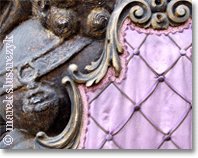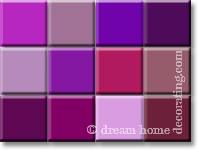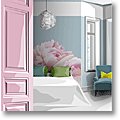Psychological Effects Of The Color Purple
Use the psychological effects of the color purple to create a rich, luxurious feel for your home.

Purple is the color of kings.
Despite this 'royal' association, the color purple is seated right amongst all the other colors on the utterly democratic Color Wheel - between red and blue, to be precise.
Purple comes in warm, reddish, more 'passionate' hues and in cooler, complex plum and indigo ones.
The psychological effects of the color purple will depend very much on how 'warm' or 'cool' the hue is:
- Bluish purples can be serene and calming and have a 'mysterious' depth.
- Reddish purples demand more attention and can dominate a room (and are always in danger of looking garish or cheap).
This page is about the effects of purple color ...
... for more info about color psychology, please go to the general psychology of color article.
Some of the psychological effects of the color purple are purely historic: In Europe, purple color has a long-standing reputation as the color of royalty and power.
For centuries, the intended psychological effect of the color purple was to show that the wearer was a VIP. The Roman emperor Julius Caesar (100BC-44BC) was so taken with the color that he decided he alone was allowed to wear it!
The tradition of reserving the color purple for members of the ruling class started in Biblical times, in countries around the Mediterranean Sea.
It is partly due to the fact that purple color was so expensive that only very rich people could afford it.

Purple color was originally 'harvested' at the coast, from the glands of the murex shellfish (and yes, the animals did die in the process).
Much later, in 1856, a young Brit invented the first synthetic (aniline) dye, and started producing the color purple on a grand scale.
His discovery sparked an international craze in dress and interior design. Everyone and their dog - and their curtains! - wanted to be seen in 'mauve'.
The color purple had suddenly become democratic.
Apart from being fashionable, purple color was also worn in England as a color of mourning until the mid-20th century.
To this day, the color purple plays an important part in the Catholic Church. It is the color of penance and martyrdom, and during the Passion of Christ, all crucifixes are covered in purple cloth.
Painters have often used purple color for the dress of the Virgin Mary (the 'Queen of Heaven'), and Cardinals wear a reddish hue of purple as a sign of their office.
There's more to tell but I'll stop here before I get completely carried away. You don't actually need loads of information to enjoy the psychological effects of the color purple!
Purple is a rich, deeply satisfying, complex color that can add real luxury to a room. (Here are some ideas for color combinations with purple!)
You don't have to be a VIP these days to surround yourself with purple color - but maybe you'll feel like one if you do.
To check out the psychological effects of other colors, take your pick from the following links:
|
Psychological Effects Of The Color White |
Psychological Effects Of The Color Grey |
Psychological Effects Of The Color Black |
|
Psychological Effects Of The Color Brown |
Psychological Effects Of The Color Orange |
Psychological Effects Of The Color Red |
Yet to find the information you're looking for? Type a word or phrase into the search box below:
Alternatively, return from Psychological Effects Color Purple to the main Color Psychology information page, or to the






New! Comments
Have your say about what you just read! Leave me a comment in the box below.